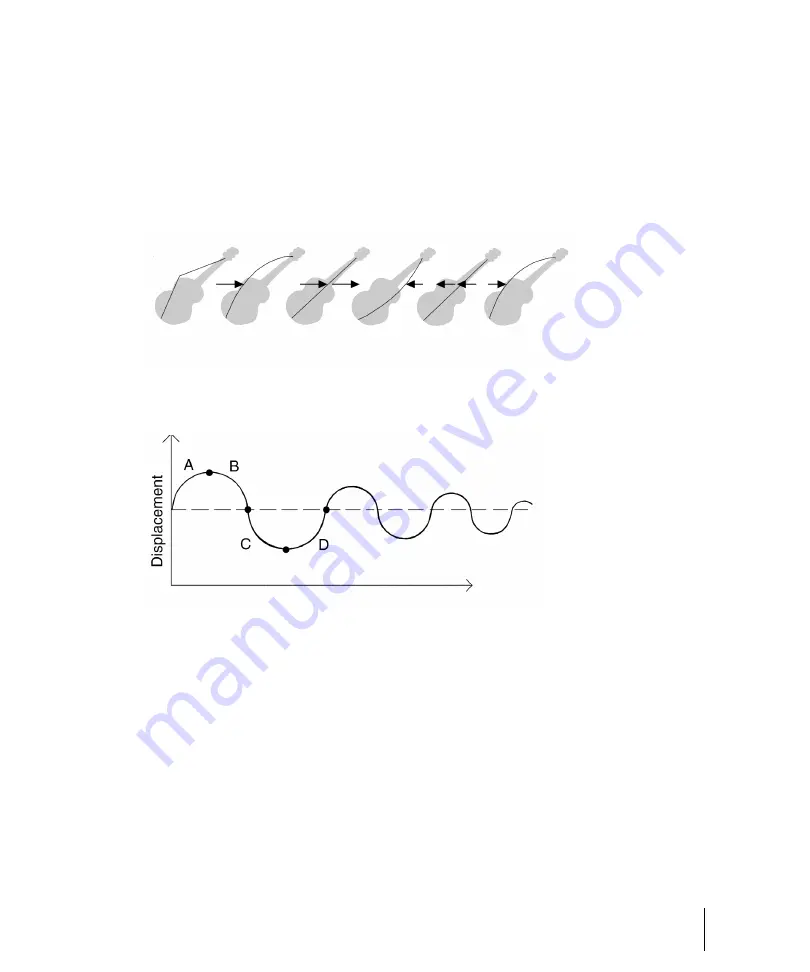
823
Digital audio fundamentals
Editing audio
Example—a guitar string
To understand the process better, let's take a closer look at a guitar string.
When a finger picks a guitar string, the entire string starts to move back and forth at a certain rate.
This rate is called the
frequency
of the vibration. Because a single back and forth motion is called a
cycle
, we use a measure of frequency called
cycles per second
, or
cps
. This measure is also
known as
Hertz
, abbreviated
Hz
. Often the frequency of vibration of an object is very fast, so we can
also express the frequency in thousands of cycles per second, or
kilohertz
(abbreviated
kHz
)
The actual distance the string moves is called its
displacement
. This is proportional to how hard the
string is plucked. A greater displacement results in a louder sound.
The displacement of the string changes as the string vibrates, as shown here:
The segment marked “A” represents the string as it is pulled back by the pick; “B” shows it moving
back towards its resting point, “C” represents the string moving through the resting point and onward
to its outer limit; then “D” has it moving back towards the point of rest. This pattern repeats
continuously until the friction of the molecules in the air gradually slows the string to a stop. As the
string vibrates, it causes the molecules of air around it to vibrate as well. The vibrations are passed
along through the air as
sound waves
. When the vibrations enter your ear, they make your eardrum
vibrate, and you hear a sound. Likewise, if the vibrating air hits a microphone, it causes the
microphone to vibrate and send out electrical signals.
In order for us humans to hear the sound, the frequency of the vibration must be at least 20 Hz. The
highest frequency sound we can hear is theoretically 20 kHz, but, in reality, it's probably closer to 15
or 17 kHz. Other animals, and microphones, have different hearing ranges.
If the simple back-and-forth motion of the string was the only phenomenon involved in creating a
sound, then all stringed instruments would probably sound much the same. We know this is not true,
Summary of Contents for sonar x3
Page 1: ...SONAR X3 Reference Guide...
Page 4: ...4 Getting started...
Page 112: ...112 Tutorial 1 Creating playing and saving projects Saving project files...
Page 124: ...124 Tutorial 3 Recording vocals and musical instruments...
Page 132: ...132 Tutorial 4 Playing and recording software instruments...
Page 142: ...142 Tutorial 5 Working with music notation...
Page 150: ...150 Tutorial 6 Editing your music...
Page 160: ...160 Tutorial 7 Mixing and adding effects...
Page 170: ...170 Tutorial 8 Working with video Exporting your video...
Page 570: ...570 Control Bar overview...
Page 696: ...696 AudioSnap Producer and Studio only Algorithms and rendering...
Page 720: ...720 Working with loops and Groove Clips Importing Project5 patterns...
Page 820: ...820 Drum maps and the Drum Grid pane The Drum Grid pane...
Page 848: ...848 Editing audio Audio effects audio plug ins...
Page 878: ...878 Software instruments Stand alone synths...
Page 1042: ...1042 ProChannel Producer and Studio only...
Page 1088: ...1088 Sharing your songs on SoundCloud Troubleshooting...
Page 1140: ...1140 Automation Recording automation data from an external controller...
Page 1178: ...1178 Multi touch...
Page 1228: ...1228 Notation and lyrics Working with lyrics...
Page 1282: ...1282 Synchronizing your gear MIDI Machine Control MMC...
Page 1358: ...1358 External devices Working with StudioWare...
Page 1362: ...1362 Using CAL Sample CAL files...
Page 1386: ...1386 Troubleshooting Known issues...
Page 1394: ...1394 Hardware setup Set up to record digital audio...
Page 1400: ...1400 MIDI files...
Page 1422: ...1422 Initialization files Initialization file format...
Page 1463: ...1463 Misc enhancements New features in SONAR X3...
Page 1470: ...1470 Comparison...
Page 1518: ...1518 Included plug ins Instruments...
Page 1532: ...1532 Cyclone Using Cyclone...
Page 1694: ...1694 Beginner s guide to Cakewalk software Audio hardware sound cards and drivers...
Page 1854: ...1854 Preferences dialog Customization Nudge Figure 518 The Nudge section...
Page 1856: ...1856 Preferences dialog Customization Snap to Grid Figure 519 The Snap to Grid section...
Page 1920: ...1920 Snap Scale Settings dialog...
Page 2042: ...2042 View reference Surround panner...






























